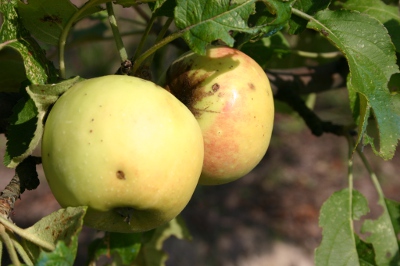︎︎︎ MELA BIANCHINA

E’ stata ritrovata nella zona di Pieve S.Stefano (AR), ma non se ne conosce l’origine. E’ ben nota nei poderi di questa parte della Toscana. Viene coltivata in queste stesse aree, in piante singole. E’ un’ottima varietà autunnale e veniva apprezzata per la sua capacità di conservazione in fruttaio. Adatta alla coltivazione di montagna ed alta collina. L’albero è molto vigoroso e rustico, a chioma espansa; produce in maniera costante e fiorisce in epoca tardiva. Il frutto è medio grande, di forma rotondeggiante, leggermente schiacciato e simmetrico. Il peduncolo è medio lungo, inserito in cavità profonda e aperta; la cavità calicina è media semiaperta. La buccia molto spessa, cerosa, è di colore verde chiaro, tendente al giallo paglierino a maturità, con poche lenticelle evidenti.. La polpa è bianca, acidula, aromatica e croccante, molto succosa e di ottima qualità. Viene raccolta tradizionalmente in ottobre, a luna calante ma si comincia a consumare in novembre. Si conserva egregiamente in fruttaio fino alla primavera successiva. Questa mela è adatta al consumo fresco e la sua ricchezza di succo la rende particolarmente gradita. Adatta anche alla cottura in forno, per la frittura, per la confettura e la salsa di mele, in passato insieme da altre varietà poteva entrare come componente delle pomate o anche negli unguenti per il corpo, così come scrive Carlo Felici nel ‘500.
It was found in the area of Pieve Santo Stefano (Arezzo) but its origin is unknown. It is quite known in the family land holdings of this part of Tuscany. It is cultivated in these same areas, in individual specimens. It is a very good autumn variety and it used to be valued for its preserving ability. It is suited for cultivation in the mountains and on high hills. The fruit is medium-large size, of round shape slightly flattened and symmetrical. The stem is average-long, inserted in a deep and open cavity; the calyx is medium sized and semi-open. The skin is very thick and waxy, of a light green colour tending to pale yellow when ripe, and has a few marked lenticels. The flesh is white, slightly sour, aromatic and crisp, very juicy and palatable. Harvest and ripening It is traditionally harvested in October, with the waning moon, but it is eaten starting in November. It keeps very well in the fruit-house until the following spring. This apple is suited for being eaten fresh and it is particularly appreciated for its rich juice. It is also suitable for baking in the oven, for making fritters, jams and sauces. In the past it would also be used in combination with other varieties to make pomades or ointments for the body, as Carlo Felici writes in the 1500’s.